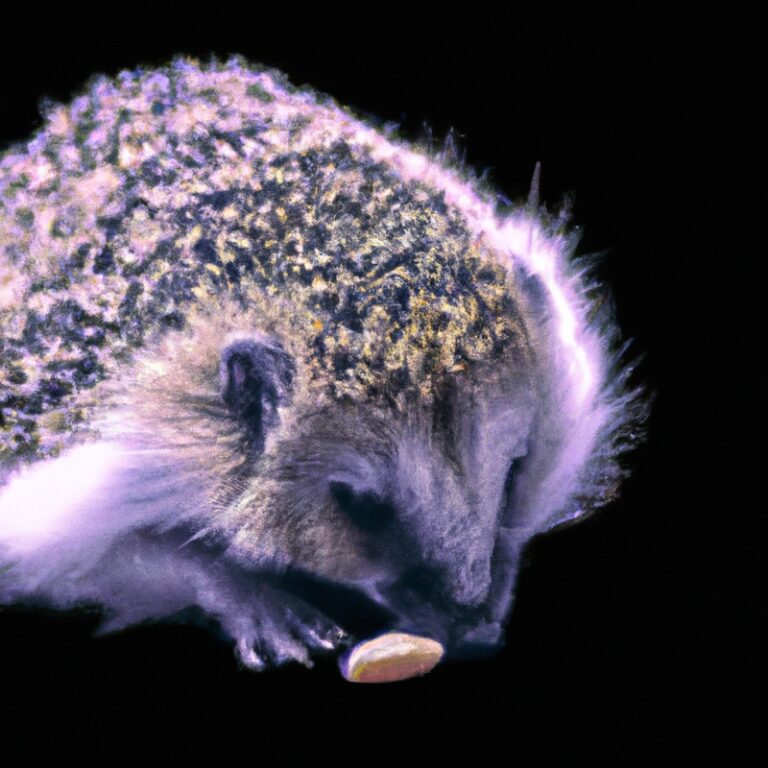How Do Hedgehogs Communicate?
Key Takeaways:
- Hedgehogs communicate through a variety of vocalizations, including snorting, hissing, and chirping.
- Hedgehogs also use body language to communicate, with behaviors such as rolling into a ball or raising their spines to signal aggression or fear.
- Scent marking is an important form of communication for hedgehogs, allowing them to mark their territory and attract mates.
- Hedgehogs have poor eyesight, so they rely heavily on their senses of hearing and smell to communicate with each other and navigate their surroundings.
Do hedgehogs have a secret language?
How do these prickly little creatures communicate with each other?
If you’ve ever wondered about the fascinating world of hedgehog communication, you’re in for a treat! In this article, we’ll uncover the intriguing ways in which hedgehogs convey their messages, from their vocalizations to their body language and even their scent marking.
Get ready to explore the social interactions, maternal communication, and cross-species connections that make hedgehogs masters of communication.
Plus, we’ll address some FAQs that will leave you even more amazed by these adorable creatures.
Get ready to dive into the captivating world of hedgehog communication!
| Method of Communication | Description |
|---|---|
| Vocalizations | Hedgehogs make a variety of sounds, including hissing, snorting, and squealing. These sounds are used to express different emotions such as fear, aggression, or mating. |
| Body Language | Hedgehogs communicate through their body postures and movements. They can curl up in a defensive posture when feeling threatened or extend their spines to appear larger. They also use their quills to express different emotions. |
| Odor | Hedgehogs have scent glands on their bodies, which they use to mark their territory and communicate with other hedgehogs. They can leave a trail of scent to indicate their presence or use their scent to signal aggression or mating readiness. |
| Tactile Communication | Hedgehogs use touch to communicate with each other. They may touch noses (known as “sniffing”) as an initial greeting or rub their bodies against each other to show affection or assert dominance. |
| Infrasound | Hedgehogs can produce low-frequency sounds that are inaudible to humans. It is believed that they use infrasound for long-distance communication, such as to locate potential mates or warn others of danger. |
Vocal Communication of Hedgehogs
Hedgehogs use vocalizations to communicate with each other.
Types of Hedgehog Vocalizations
Hedgehogs communicate through a variety of vocalizations. They make clicking sounds when they are content or exploring their environment.
If they feel threatened or scared, they emit a high-pitched hissing sound.
When hedgehogs are alarmed or in pain, they may produce a loud, piercing shriek. Although hedgehogs are more known for their physical defense mechanisms, their vocalizations play a key role in expressing their emotions and communicating with other hedgehogs.
What Do Different Hedgehog Sounds Mean?
Hedgehogs communicate through a variety of sounds that carry different meanings.
Snorting or hissing noises indicate aggression or fear, usually as a defensive response.
Purring sounds, similar to a cat’s purr, indicate contentment and relaxation.
Chirping or clicking sounds are often signs of excitement or anticipation.
Growling or grunting sounds can indicate annoyance or discomfort.
It’s important to pay attention to these different sounds to better understand and respond to your hedgehog’s needs and emotions.

Non-vocal Communication of Hedgehogs
Hedgehogs use various non-vocal cues to communicate with each other. These include body language, scent marking, and other signals.
Body Language of Hedgehogs
Hedgehogs, despite their adorable appearance, have a unique way of communicating through their body language.
When they feel threatened or scared, they will roll up into a tight ball, with their spines acting as a protective barrier.
This defensive posture is their way of telling you to back off and leave them alone.
On the other hand, if a hedgehog feels comfortable and at ease, it will uncurl and explore its surroundings, sniffing and prodding with its nose.
Additionally, hedgehogs may also communicate through their ears and eyes.
For example, if a hedgehog’s quills are relaxed and it has wide-open eyes, it is likely in a content and relaxed state.
However, if it flattens its quills and squints its eyes, it may be feeling defensive or agitated.
Paying attention to a hedgehog’s body language can give you valuable insights into its emotions and help you understand how to interact with it appropriately.

Scent Marking in Hedgehogs
Hedgehogs communicate through scent marking. They have scent glands located on their bodies that release a distinct odor.
By rubbing against objects, they leave their scent behind, marking their territory.
This helps them to communicate with other hedgehogs and establish boundaries. Scent marking also plays a role in attracting potential mates during the breeding season.
Additionally, hedgehogs may use their urine to mark their territory.
So, scent marking is an important form of non-vocal communication for hedgehogs.
Other Non-vocal Communication Signals of Hedgehogs
Hedgehogs communicate through various non-vocal signals.
One important signal is their body posture.
When a hedgehog is feeling threatened, it may curl into a ball as a defensive mechanism.
On the other hand, a relaxed and open posture signifies a sense of safety and comfort.
Another signal is scent marking.
Hedgehogs release a distinct odor from their skin glands, which helps them communicate with other hedgehogs and mark their territory.
Finally, hedgehogs use quill erection as a visual communication signal.
When they feel threatened or agitated, they raise their quills to appear larger and more intimidating.
Social Interactions of Hedgehogs
Hedgehogs engage in various social interactions, including courtship behavior, aggression and defense mechanisms, as well as group communication and social hierarchies.
Hedgehog Courtship Behavior
Hedgehog courtship behavior is an interesting process.
Male hedgehogs will approach a female and engage in a series of behaviors to show interest.
This may include sniffing, circling, and vocalizations.
The female will respond by allowing the male to approach and mate.
Courtship behavior is important for hedgehogs to ensure successful reproduction.
It’s fascinating how animals communicate and navigate the complexities of courtship.
Hedgehog Aggression and Defense Mechanisms
Hedgehogs are generally not aggressive animals, but they do have defense mechanisms to protect themselves. When they feel threatened, hedgehogs may curl into a tight ball with their spines sticking out, making it difficult for predators to attack them.
If this defensive posture doesn’t deter the predator, hedgehogs may start hissing, growling, or even lunging at their aggressor.
Occasionally, they may also release a foul-smelling odor as a deterrent. It’s important to give hedgehogs their space and avoid actions that may frighten or threaten them.
Group Communication and Social Hierarchies
Group communication is vital for hedgehogs to establish social hierarchies and maintain cohesive relationships. Through vocalizations, such as snuffling, hissing, and puffing, they convey messages to other members.
They also use body language like raising their quills and posturing to assert dominance or submission.
These interactions help hedgehogs establish their rank within the group, ensuring peaceful coexistence and efficient distribution of resources. Additionally, grooming each other fosters social bonds and strengthens their group dynamics.
Communication Between Mother and Offspring
Communication between mother and offspring is vital for their survival and development.
Let’s explore how hedgehog mothers communicate with their young.
Mother Hedgehog Communication During Pregnancy
During pregnancy, mother hedgehogs communicate with their offspring through a variety of ways.
They emit low-frequency sounds to establish a bond and provide comfort.
They also use tactile communication, such as gentle nudging, to stimulate the growth and development of the embryos.
Furthermore, mother hedgehogs use chemical signals, known as pheromones, to convey important information to their offspring, such as the availability of food or potential dangers in the environment.
These communication methods help ensure the well-being and survival of the hedgehog babies.
Mother Hedgehog Communication with Newborns
Mother hedgehogs communicate with their newborns primarily through vocalizations and physical contact.
They make soft, purring sounds to reassure and comfort their babies.
Additionally, mother hedgehogs use their sense of smell to recognize their offspring’s individual scent, allowing them to locate and care for them.
Through these forms of communication, mother hedgehogs ensure the well-being and bonding with their newborns.
Importance of Communication for Offspring Survival
Communication is vital for the survival of offspring in the animal kingdom.
It helps them stay connected with their parents and navigate their environment more effectively.
Through communication, offspring receive important information about food sources, danger, and social interactions.
They learn crucial skills and behaviors from their parents, which are essential for their survival.
Additionally, communication helps build strong bonds between parents and offspring, ensuring their protection and well-being.
Overall, effective communication greatly enhances the chances of offspring survival in the animal world.
Cross-species Communication with Hedgehogs
Hedgehogs have limited cross-species communication abilities, but they can interact with both humans and other animals in certain ways.
Communication between Hedgehogs and Humans
When it comes to communication between hedgehogs and humans, it’s important to understand that hedgehogs rely on a combination of vocalizations, body language, and scent markings to interact with their surroundings.
While they are not known for being particularly vocal, hedgehogs may emit soft, high-pitched squeaks or grunts when they are distressed or alarmed.
They also communicate through their body language, such as raising their spines or curling into a tight ball when feeling threatened.
Additionally, hedgehogs use scent markings to communicate their territory and attract potential mates.
By observing and respecting their behaviors, you can create a positive and respectful interaction with these adorable spiky creatures.
Communication between Hedgehogs and Other Animals
Hedgehogs primarily communicate with other animals through a combination of vocalizations, body language, and scent marking. They use a variety of sounds, including snuffling, hissing, and squealing, to express their emotions and communicate with other hedgehogs.
Additionally, they rely on body postures, such as rolling into a ball or arching their spines, to signal aggression or submission.
Hedgehogs also mark their territory using scent glands, which help them establish boundaries and communicate their presence to other animals.
FAQs about Hedgehog Communication
Can Hedgehogs Understand Human Voices?
Hedgehogs are known for their excellent sense of hearing, so they can definitely hear human voices.
However, whether or not they understand what we’re saying is a different story.
Hedgehogs primarily communicate through a combination of grunts, clicks, and hisses, which may not align with our spoken language.
While they can recognize familiar sounds, it’s unlikely that hedgehogs can comprehend the meaning behind human words.
So, while they can hear us, they might not understand us in the same way.
Do Hedgehogs Communicate with Other Hedgehog Species?
Hedgehogs do not communicate with other hedgehog species. Each species of hedgehog has its own unique set of vocalizations, body language, and scents to communicate with members of its own species.
While they may have similar behaviors and communication methods, these signals are specific to their own kind.
Hedgehogs primarily use communication to establish territories, ward off predators, and attract mates within their own species.
Can Hedgehogs Communicate Using Infrasound?
Hedgehogs do not communicate using infrasound.
They primarily rely on vocalizations, body language, and scent markings to communicate with each other.
Vocalizations include snorting, grunting, and hissing sounds, while body language involves behaviors such as curling into a ball or raising quills.
Scent marking is also important for leaving messages for other hedgehogs in their territory.
While some animals use infrasound for communication, hedgehogs have not been observed to have this ability.
Final Verdict
Hedgehogs communicate through a combination of vocal and non-vocal signals, as well as social interactions. Vocal communication includes a variety of sounds that convey different meanings, while non-vocal communication involves body language, scent marking, and other signals.
Social interactions play a crucial role in courtship behavior, aggression, and the establishment of social hierarchies.
Mother hedgehogs also use communication to care for their offspring during pregnancy and after birth. While hedgehogs can communicate with humans and other animals, their ability to understand human voices, communicate with other hedgehog species, and use infrasound is still a subject of study.
Understanding hedgehog communication is vital for their well-being and can provide us with insights into their fascinating lives.
So, next time you encounter a hedgehog, pay attention to their vocalizations, body language, and social interactions, as it is through these means that they express and navigate their world.







